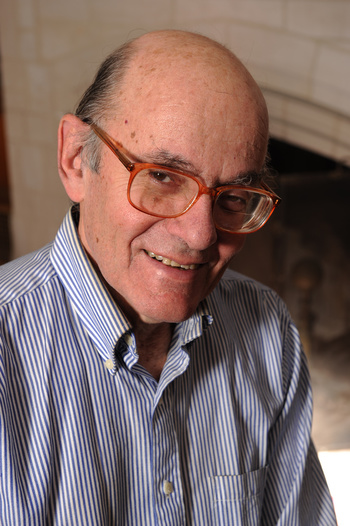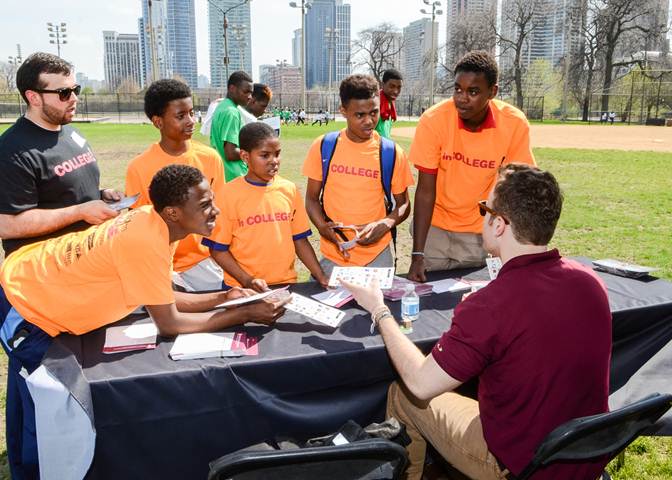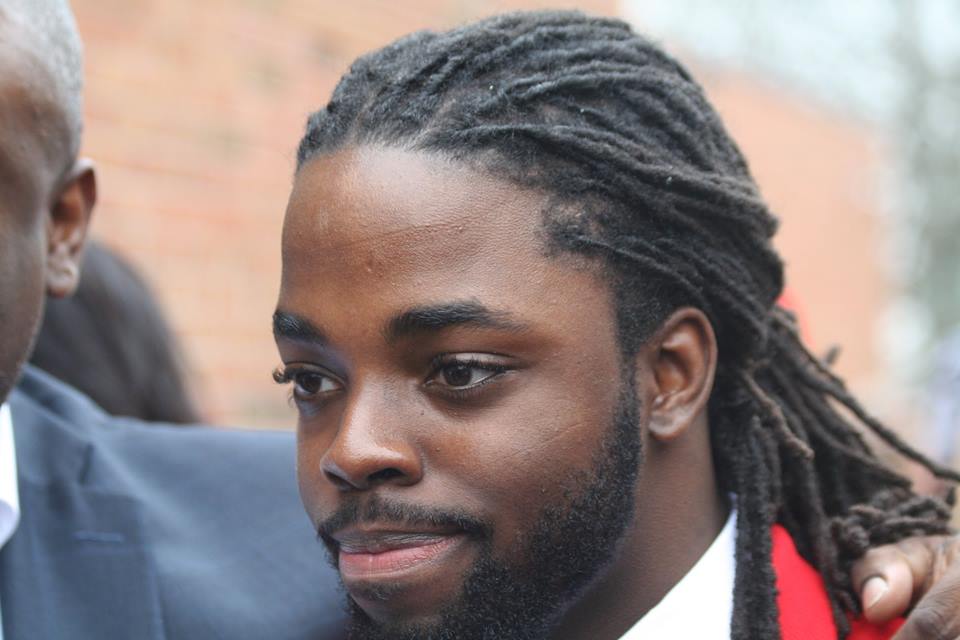Blog & News
College Graduation by Zip Code
by Marci Koblenz, President, Center for Companies That Care
Today, December 13, 2014 is a proud day! After an 8 year investment that began when he was in 9th grade, the first AIM High student graduated from college!! Congratulations to Anthony Hubbard!! More AIM High students will graduate from college this spring and more will continue to graduate every year from now on. We ARE making a difference.
Still, I fall asleep each night asking myself what more can we do, because the need is greater than our efforts can meet.
Here are the facts. Seventy three percent (73%) of students growing up in the top 25% of family income will graduate from college. The national college graduation rate among our students, and others like them growing up in the bottom quartile of family income, is a mere 8%.
Who Graduates from College?
|
73% |
vs |
8% |
|
Students from Wealthy Families |
|
Students from Poor Families |
You might be thinking that the disparity is due to the quality of schools in different neighborhoods, but in fact, it isn’t. Low income students are NOT FLUNKING out of college, they are being forced out of college because they are poor. When my college student daughter receives notification about additional fees, she forwards the invoice home and forgets about it. She (correctly) assumes that we, her parents, will pay for it. Most AIM High students don’t have anyone at home who can pay their fees. Then what happens? For poor students, this means college is over. Did you know for example that a student cannot return to college “next” semester if they owe money to the school? Even if the amount they owe is less than $100? Even if they didn’t know their financial aid didn’t cover the fee?
Two years ago, a friend asked how Center for Companies That Care would use a donation that was solely for the purpose of preventing students from not finishing college. I immediately said “we would pay the small expenses the students didn’t know about and are preventing them from enrolling for the next semester.” That kind, generous friend, gave us $20,000 just for this purpose. And it’s working so well that other nonprofits have adopted the same practice. But the money is running out.
We are working toward systemic change in the financial aid system, but in the meantime, your donation can cover college fees and prevent another unnecessary dropout.
|
Printing fees at a public printer (because AIM High students don’t have their own printer) |
$50 |
|
Lab fees |
$250 |
|
Health insurance |
$900 |
|
Required tuition payment before financial aid is distributed, plus interest |
$12,874 |
Some folks say “college isn’t for everyone.” I agree. But, whether one follows a college path should NOT be determined by zip code. One of my favorite quotes is “we make a living by what we get; we make a life by what we give.” I know your life is already filled with giving, but I’m asking you to enhance your life a little more by donating here . Thank you in advance for sharing your resources in order to enable ALL students, regardless of family income, to pursue a college degree.
With warm wishes for happy holidays and a better 2015,
Marci
The White House College Opportunity Day of Action

Reflections on The White House College Opportunity Day of Action
by Marci Koblenz, President
I am honored and proud that Center for Companies That Care was invited to attend The White House College Opportunity Day of Action last Thursday, December 4th. It was thrilling to be part of approximately three hundred college presidents and a handful of nonprofit, corporate and government leaders all focused on the same issue of dramatically increasing the number of post-secondary (post high school) degrees.
Most of the day was spent listening to presentations with one break-out session over lunch. It was very exciting to hear live presentations from Education Secretary Arne Duncan, Vice President Joe Biden, First Lady Michelle Obama, and President Obama. The day ended by walking to President’s Park, directly behind the South Lawn of the White House for the annual Christmas Tree Lighting Ceremony.
My objective in attending was to learn things I didn’t know, and to identify a network of others who are as concerned as we are about the #1 deterrent to college graduation: poverty. I am happy to tell you both my goals were achieved.
Learnings
There were many new learnings, of course, but the two most striking were these.
- Current Practices aren’t Good Enough -- I knew that President Obama had set a Big Goal – to again lead the world in college graduates by 2020 (a distinction we had in 1990; but have now dropped to 12th). I had assumed that reaching this goal required more efforts to help students go to and stay in college. Instead, I learned that unless we completely change how we deliver post-secondary education, it will be impossible to reach that goal because there aren’t enough slots. Post-secondary education as we know it must be re-invented. This will require collaborative efforts among the many education stakeholders across silos that may not have been crossed before. While feeling disheartened to learn this is an even larger task than I had imagined, I also realized that Center for Companies That Care is already (unintentionally, but fortunately) working in this space. Last summer we launched the Summer Stretch and STEM Institute. One piece of our strategy is to offer MOOC’s (Massive Open Online Courses) from top tier colleges to our high school and college students in a facilitated group setting. Our rationale is to build the resumes and confidence of our students. We know they are capable of doing college level work, but unless they believe it, they could become their own biggest obstacle. Now we have an additional good reason to build the Summer Institute: to participate in developing alternative forms of providing post-secondary education.
- Integrate Students’ Parents -- It was Vice President Joe Biden who contributed my second big learning of the day. He spent a lot of time talking about the parents of 1st generation college students and he helped me understand their experience in ways I hadn’t thought about before. He talked a lot about his very “proud” father whom he didn’t really understand until he became a parent himself. Vice President Biden realized his father never visited colleges with him because he was embarrassed that he couldn’t be a resource to Joe since he didn’t know anything about the world of college. He was embarrassed again when his bank turned him down for a loan and he had to tell Joe that he couldn’t help him pay for college. The Vice President reminded us that college not only causes pain for the 1st generation students, but also for the parents and extended families of the students as well. As a parent myself, I have always been sensitive to the possibility that parents may feel threatened by strong relationships between their children and their mentors and consequently we encourage mentors to reach out to parents. Parents will always be the most influential adult in our students’ lives and we want to support their dreams for their children. I understand now that Center for Companies That Care can do even more for parents to support them as their child’s primary “go to” person. I’m not sure what that support will look like, but I’m sure parents have great ideas that I want to collect!
Finding a Network
Over lunch, we were each assigned to a small breakout session. My session was College Completion: A Campus Perspective. We were challenged to discuss with our neighbor what was needed to create a college culture of completion and then report out. I went to the conference wondering whether the issue we are most focused on in Chicago (the fact students are unable to complete college due to a lack of financial resources, for school fees in particular) had risen to the national level. It has not, but there is reason to be hopeful that it’s moving up the agenda. I spoke up about this issue in my small group and was rewarded with the President of Morgan State College standing to validate what I had said and to report they had done a thorough and comprehensive assessment of why their students are not graduating and they learned it was due to (a lack of) financial resources.
President Obama, during his talk, also focused on the (un)affordability of college, but specifically for the middle class. I agree with this concern, but worry that his focus on the middle class contributes to the myth that financial aid meets the financial needs of low income students. It does not. He also talked about the financial risks of college; something I stay up nights worrying about, but hadn’t heard him comment on before. He reminded us that we, those who work with college students, have a responsibility to be successful at “solving” the college completion issue because otherwise, any student who takes a loan and doesn’t graduate will be worse off than if they hadn’t attended college at all. I was relieved to hear that this issue is visible to the highest levels of government.
Final Thoughts
The conference did not conclude with a series of next steps, but I expect I will be hearing more in the coming weeks. I came home with a renewed sense that our work is critically important for the global leadership of our nation and that we are on the right path.
Prior to the conference, I had dinner with an AIM High student who is a Senior at Georgetown. She is smart, personable, and ambitious. Her grades are outstanding. Still, it has not been an easy road. We talked about the two concurrent narratives that exist in our country about privilege; the narrative that says every American is equal, and the narrative that says some Americans, based on race and socio-economic status, have it easier than others (an example is in this just published article in the Boston Globe).
Michelle Obama spoke about “two worlds” – one in which high school students receive personalized college counseling from individuals who have a small enough case load to work closely with each student, and the other, where there is a ratio of 471 students to one counselor and it is impossible to provide valuable guidance. She is leading an initiative to expand the number of college counselors. In the meantime, our staff and mentors are filling the gap.
Center for Companies That Care, by the nature of our work, works closely with people who subscribe to both narratives. While we could ignore the issue and treat privilege and college graduation as two unrelated constructs, that serves no one’s interest. Which narrative is “true” is far less important than the necessity to hear each other and figure out how to get along as professional and community neighbors who must live and work together peacefully despite carrying different belief systems. No doubt there are many beliefs we don’t share, yet our ideas about privilege seem to be particularly fraught with tension. I am returning from the conference, not with a goal of “solving” these differences, but of listening openly and making it easy for all voices to be heard. Enabling all students, regardless of socio-economic background, to graduate from college is a necessity for all voices to emerge and for our country to regain its #1 global position.
Read more about The White House College Opportunity Day of Action.
Read about the 600 Commitments that were made to support increased post-secondary degrees.
AIM High's Marvin Hoffman Is Interviewed by CATALYST

Bottom line is economic inequity: "Whatever the particular design strategy, all of these programs are wrestling with problems that reflect the fundamental inequities of our economic system. The low-income students who represent the vast majority of those in CPS are operating without the safety net that is invisible to most middle-class families—so invisible that they recognize it as little as fish recognize the medium of water that sustains them." To read full article, click here
5K March to College 2014 Covered by Citizen
Click here to check out Lee Edwards' coverage of the 2014 5K March to College in The Chicago Citizen.

Page 4 of 8

